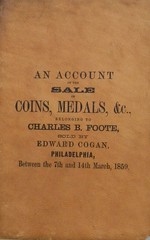
About UsThe Numismatic Bibliomania Society is a non-profit organization devoted to the study and enjoyment of numismatic literature. For more information please see our web site at coinbooks.org SubscriptionsThose wishing to become new E-Sylum subscribers (or wishing to Unsubscribe) can go to the following web page link MembershipThere is a membership application available on the web site Membership Application To join, print the application and return it with your check to the address printed on the application. Membership is only $20 to addresses in the U.S., $25 for First Class mail, and $30 elsewhere. For those without web access, write to: David M. Sundman, Treasurer
AsylumFor Asylum mailing address changes and other membership questions, contact David at this email address: dsundman@LittletonCoin.com SubmissionsTo submit items for publication in The E-Sylum, just Reply to this message, or write to the Editor at this address: whomren@gmail.com BUY THE BOOK BEFORE THE COIN |
- WAYNE'S WORDS: THE E-SYLUM NOVEMBER 9, 2014
- KOLBE & FANNING BALTIMORE SALE #137 PRICES REALIZED
- NEW BOOK: STANDARD CATALOG OF WORLD COINS, 1601-1700, 6TH ED.
- NEW BOOK: THE LONDON MINT OF CONSTANTIUS AND CONSTANTINE
- NEW BOOK: NEW ZEALAND COMMEMORATIVE MEDALS 1941-2014
- ANS APPOINTS DAVID HILL AS LIBRARIAN
- ANS ORIENTAL NUMISMATIC BOOK FUND DONATIONS SOUGHT
- ANSWERS: WHAT IS THE DEFINITION OF BRONZE?
- NOTES FROM E-SYLUM READERS: NOVEMBER 9, 2014
- MORE NUMISMATIC REMEMBRANCES OF EDGAR ALLAN POE
- HARVEY STACK ON BOOKS AND THEIR VALUE, PART 2
- 1859 FOOTE SALE INSCRIBED TO LEDYARD HODGE
- TWO ORIGINAL CONFEDERATE HALF DOLLARS COME TO MARKET
- CIVIL WAR TOKENS OF ALLEGHENY CITY
- HAND-ENGRAVED CONFEDERATE DAVIS FLIGHT MEDAL
- CHINESE GOLD-PLATED TUNGSTEN BULLION COIN COPIES
- MORE ON THE CHIEF THREE FINGERS INDIAN PEACE MEDAL
- SELECTIONS FROM NOBLE NUMISMATICS SALE 107
- SOME INTERESTING MEDALS: NOVEMBER 9, 2014
- HOWARD BERLIN VISITS TALLINN, ESTONIA
- SCHOOL COLLECTION DONATED TO SMITHSONIAN
- EXHIBIT: THE FAKES, LIES AND FORGERIES
- PERU'S 10 SOLES BANKNOTE TURNS GREEN
- WEB SITES PROMOTE WOMEN ON CANADIAN BANKNOTES
- EAST GERMANY'S PHANTOM BANKNOTES
- BALTIMORE BAR INSTALLS BITCOIN ATM
- YORKSHIRE COIN HOARDS EXHIBITED ONLINE
- BOARS, HOGS, SOWS AND PIGLETS ON ANCIENT COINS
- NUMISMATIC ITEMS DATED BY MONTH
- FEATURED WEB PAGE: NUMISTA: GRIQUATOWN PENNY
Click here to access the complete archive
To comment or submit articles, reply to whomren@gmail.com
WAYNE'S WORDS: THE E-SYLUM NOVEMBER 9, 2014

New subscribers this week include: Isabelo Toledo and Douglas Jurgens. We now have 1,786 subscribers.
Next week another new advertiser will debut and Hedley Betts' ad will return (like a nearby comet, it's on a two-month cycle). Meanwhile, note the fine print on the Second Story Books ad - the discount on the John Huffman numismatic library titles has been raised to 30%, so their site may be worth a fresh look.
Thanks again to all of our advertisers for their support at all levels. Be sure to support them in turn, dear readers. Check out their offerings and be sure to thank them whenever you have a chance.
This week we open with a post-sale report on the Kolbe-Fanning Baltimore literature auction, three new books, and a couple items relating to the American Numismatic Society. Other topics include bronze and brass, Edgar Allan Poe medals, Confederate Half Dollars, deceptive Chinese gold coin copies, coin hoards, and numismatic items dated by month or day.
To learn more about New Zealand's commemorative medals, Peru's whiter shade of pale, gifts and presents to friends owning good taste, and the mysterious bird with a one-word vocabulary, read on. Have a great week, everyone!
Wayne Homren
Editor, The E-Sylum
KOLBE & FANNING BALTIMORE SALE #137 PRICES REALIZED
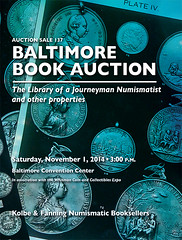 Kolbe & Fanning Numismatic Booksellers
conducted a public auction of important numismatic books on November 1, 2014 in Baltimore, Maryland
in conjunction with the Whitman Coin & Collectibles Expo at the Baltimore Convention Center.
The sale was a resounding success, bringing over 110% of estimate and setting some new records for
prices.
Kolbe & Fanning Numismatic Booksellers
conducted a public auction of important numismatic books on November 1, 2014 in Baltimore, Maryland
in conjunction with the Whitman Coin & Collectibles Expo at the Baltimore Convention Center.
The sale was a resounding success, bringing over 110% of estimate and setting some new records for
prices.
The sale featured the outstanding library of a Journeyman Numismatist and other properties, and focused on early American numismatics and closely related foreign areas. Some highlights included the following (all prices are hammer prices):
--An extraordinary 31 different plated Chapman sales, some of which commanded exceptional prices, including: the H.P. Smith sale (lot 34 at $3500), the George H. Earle sale (lot 42 at $4000) and the Bascom & Brown sale (lot 47 at $4750).
--No fewer than 10 plated Thomas Elder catalogues, including Lyman Low’s copy of the 1917 Carlton sale (lot 93 at $3500), the Hewitt & Bartlett sale (lot 94 at $3750), the 1920 Miller sale (lot 96 at $5500), and the McMullin sale (lot 97 at $3500).
--Abe Kosoff’s hugely important archives on the Josiah Lilly collection and the controversy surrounding its acquisition by the United States as part of the National Numismatic Collection (lot 124), which brought $15,000 to an overseas bidder.
--Lot 149, the breathtaking original photographic paste-ups of the plates for the 1975 EAC sale, featuring the fabled collection of Connecticut coppers formed by Q. David Bowers, which sold for $8500.
--A rare plated copy of Wayte Raymond’s 1925 W.W.C. Wilson sale (lot 151), sold for a strong $8000, with a copy of the 1926 Wilson II sale (lot 153) bringing an extraordinary $1500.
--An illustrated notebook prepared by Edgar H. Adams covering Connecticut, New York, Vermont and Confederatio coppers and the coinage of William Wood, and a second one covering Massachusetts silver and copper coins, which sold for $6500 and $7500, respectively.
--George H. Clapp’s very rare suite of photographs titled Type Set of United States Cents 1793-1857 (lot 59), which sold for $3500.
--A first edition Crosby with both the 1873 and 1875 title pages, as well as the Maris Woodburytype plate and other special content bound in (lot 78), which sold for $3750.
--Strobridge’s 1873 Descriptive Catalogue of the Seavey Collection of American Coins (lot 186), sold for $3750.
--Catalogues by W. Elliot Woodward were in especially strong demand, with Charles Nichol’s exceptional copy of the Mickley sale (lot 202) selling for $2200, a plated copy of the 1884 Ely sale (lot 206) bringing $1700, the 1884 Levick sale with plates (lot 207) bringing $2600, and the rare 1886 Twining sale with plates (lot 211) selling for an extraordinary $3000 on a $300 estimate.
The sale was the first public auction conducted by the firm in conjunction with the Whitman Baltimore show, and the response from all parties involved was very positive. Live internet bidding was provided through Kolbe & Fanning’s live auction site managed by icollector.com, and ran smoothly. The catalogue and prices realized list can be accessed on the Kolbe & Fanning website at www.numislit.com.
While, as usual, our established clientele actively participated in the sale, it must be noted that this auction attracted very strong bidding from a new generation of numismatic collectors, dealers and bibliophiles. The classics of American numismatic numismatics in nearly all instances brought prices commensurate with their desirability, and demand for rare and desirable American auction sale catalogues and standard works appears to be boldly entering a new era.
We wish to thank everyone who participated and we look forward to 2015.
NEW BOOK: STANDARD CATALOG OF WORLD COINS, 1601-1700, 6TH ED.
 Standard Catalog of World Coins, 1601-1700
Standard Catalog of World Coins, 1601-1700
6th Edition
By George S. Cuhaj and Thomas Michael
The Standard Catalog of World Coins 1601-1700 is the most complete volume on coins of the 17th century available on the market today. In this completely revised and updated 6th edition, a worldwide network of experts continues to uncover collector coin issues never before published.
In addition to a complete overhaul of information and hundreds of new high-quality images, this catalog offers invaluable information from identification to values of all coins found in the world during this time period. For the collector or simply the researcher attempting to identify world coins, this is the perfect single source.
Features of this up-to-date guide:
- Hundreds of new-and-improved images for easy identification
- In-depth descriptions for accurate identification
- 22,000 actual-size images for easy identification
- Current market values in up to 5 grades
- Expanded German and Italian State listings
- Features nearly 300,000 accurate coin prices
About the Authors:
George Cuhaj has served the Krause Publications numismatic staff for 20 years. Before becoming an
editor with the Standard Catalog of World Coin series he worked for the American Numismatic Society
and as a cataloger for Stack's Rare Coins, both of New York City. Cuhaj is past president of
the American Medallic Sculpture Association and his art medal creations have been show
internationally.
Thomas Michael has served as a market analyst for 25 years at Krause Publications, which holds a reputation for creating the world's best-selling coin books. Michael holds a bachelor's of arts degree in history and a mast of arts degree in economics.
Retail: $90.00 | Your Price: $52.99
For more information, or to order, see:
Standard Catalog of World Coins, 1601-1700
(www.shopnumismaster.com/standard-catalog-of-world-coins-1601-1700-group?et_mid=700731&rid=238176646)
NEW BOOK: THE LONDON MINT OF CONSTANTIUS AND CONSTANTINE
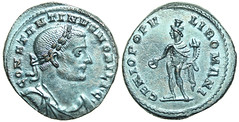 The London Mint of Constantius and
Constantine
The London Mint of Constantius and
Constantine
by Hugh Cloke and Lee Toone
A comprehensive catalogue and survey of the output of the London mint from AD 296 to 325. From when Constantius invaded Britain to regain the Britannic Empire back from Allectus to its closure in 325 when Constantine began to shift his power base to the East, the London mint was responsible for a vast output of Roman coinage. In The Roman Imperial Coinage (RIC) around 600 types were listed; the authors of this book have increased the number of known types to 995 and have illustrated nearly 95% of these with images on plates facing the catalogue tables in sylloge style. They have also provided a hoard census which lists numbers for each type found in four major hoards. This enables an objective rarity value to be assigned to each coin type.
Supported with a comprehensive narrative, indices and a concordance with RIC, this will become the standard reference work on the London mint for years to come.
Published by Spink
Expected early 2015
Price : to be confirmed
Further information is expected shortly and if you want to be added to the mailing list, email books@spink.com or call +44 (0)20 7563 4000

NEW BOOK: NEW ZEALAND COMMEMORATIVE MEDALS 1941-2014
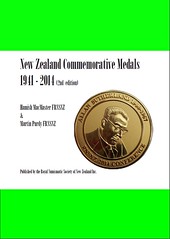 Hamish MacMaster’s 2009 Commemorative Medals
catalog, covering the period from 1941, has been revised and updated as a new second edition by
Hamish and Martin Purdy as joint compilers, and was launched at the International Numismatic
Conference in Wellington on July 3 this year.
Hamish MacMaster’s 2009 Commemorative Medals
catalog, covering the period from 1941, has been revised and updated as a new second edition by
Hamish and Martin Purdy as joint compilers, and was launched at the International Numismatic
Conference in Wellington on July 3 this year.
It is now printed on gloss paper, with larger images (50mm rather than 35mm), with many new discoveries and additions since publication of the 1st edition in 2009. Almost totally reworked following the first edition, this new book covers over 500 individual commemorative medals, in addition to various modern “collector series” listed in a separate appendix.
An innovation this time is a full index of legends, so if your medal is undated or you can’t find it for some reason, the index can be used to find the right reference number. Soft cover, 314 pages, A4 format, semi-gloss paper, black-and-white images, all enlarged, sharpened and cleared of background matter for clarity.
The catalog is not intended as a price guide, though some selling prices observed by the authors have been recorded. The companion price guide to the 1st edition by Anthony Grant is recommended for this purpose.
This is the third in a projected short series of specialized catalogs of NZ exonumia published by the Royal Numismatic Society of New Zealand.
It can be ordered from the RNSNZ, PO Box 2023, Wellington 6140, New Zealand, e-mail martin_lists@yahoo.com .
Price including international postage from New Zealand: NZ$90 or US$72.
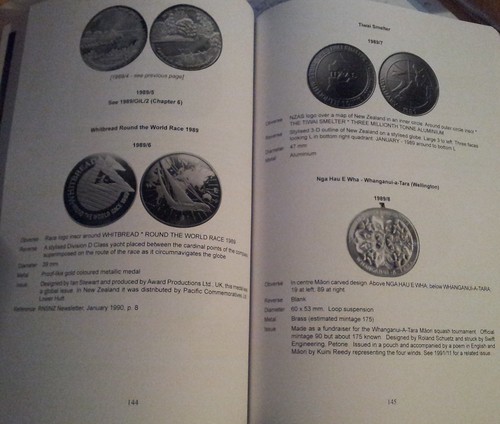
ANS APPOINTS DAVID HILL AS LIBRARIAN
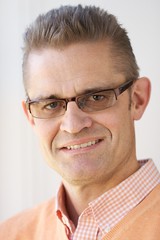 The American Numismatic Society is pleased to announce the
appointment of David Hill as its Francis D. Campbell Librarian. He will take up the position on
November 17, 2014.
The American Numismatic Society is pleased to announce the
appointment of David Hill as its Francis D. Campbell Librarian. He will take up the position on
November 17, 2014.
Selected from a broad pool of candidates after an extensive search, David brings twenty years of library and archives experience to the position. He holds a master of library science degree from the University at Albany as well as undergraduate and graduate degrees in American history. His professional work has included positions at the Columbia University Archives and Columbiana Library, where he served as assistant director, as well as the Berkshire County Historical Society (Massachusetts) and the Westchester County Archives. David has demonstrated a knowledge of numismatics, having served as the ANS’s part-time Archivist for last five years. He has published his research in articles on a variety of numismatic subjects, including the Chapman Brothers coin firm, the opening of the Shanghai Mint, and coin scholar and ANS president Edward Newell. David’s article on the French medalist Louis-Oscar Roty will be published in the next issue of ANS Magazine. During his time as the Society’s Archivist, David also served as a reference librarian at Iona College in New Rochelle, where he showed an eagerness and aptitude for public service, assisting and instructing students, staff, and community patrons.
During his time at the ANS, David has worked closely with the Society’s web and database developer Ethan Gruber in the development of ARCHER, the online archives publication system. This tool, which began as a means to publish archival finding aids online, now includes a platform for displaying full-text page scans that can be linked into other online systems, with the handwritten notebooks of Edward Newell serving as the first test case. “This is a very exciting development,” David says, “and one that I see being applied not only to manuscripts but to the older published works in the library, such as auction catalogs. I’m looking forward to working with the curatorial staff as we integrate digitized library resources with systems like the Online Coins of the Roman Empire (OCRE) and the MANTIS coin database.”
Dr. Ute Wartenberg Kagan, Executive Director of the Society, said, “I am very pleased that David Hill will take over this key position in our organization and continue the work carried out by his predecessors, Elizabeth Hahn Benge and Francis D. Campbell.” The Harry W. Bass Jr. Library of the Society is one of the most important numismatic libraries in the world, housing over 100,000 items related to numismatics and related fields. The archives, which contains records of both the Society and various members, dealers, and collectors, has become an important source for researchers in U.S. and world numismatics.
ANS ORIENTAL NUMISMATIC BOOK FUND DONATIONS SOUGHT
Help Fill in the Gaps in the Oriental Numismatics Collection of the Harry W. Bass Jr. Library
The American Numismatic Society not only houses one of the largest collections of Oriental coins in the world, it also publishes books on Oriental numismatics, including a soon-forthcoming major study of Kashan coinage and a study of the banknotes of the Imperial Bank of Persia. Naturally, the Society’s Harry W. Bass Jr. Library would like to keep pace. But it is difficult for the staff to identify what has been published in Oriental numismatics without input from specialists in Islamic, South Asia, Southeast Asian and East Asian numismatics.
That is where Prof. Jere L. Bacharach comes in. Prof. Bacharach, an ANS Trustee as well as a member of the Oriental Numismatic Society, has been diligently checking each issue of the Journal of the Oriental Numismatics Society (JONS) and then consulting with the Bass Library staff to help identify what items the library is missing. The effort is rewarding: a review of the past four issues of JONS, for example, revealed that there are 13 recently published works the library does not own.
Still, identifying such missing items is not quite enough. There remains the critical issue of securing the funds to acquire them.
And that is the point at which Dr. Ute Wartenberg Kagan, Executive Director of the ANS, enters the picture. Dr. Wartenberg Kagan has found an anonymous donor who will contribute up to $1,000 in matching funds, in blocks of $50, to buy books listed in JONS that the ANS does not have. That is, for each U.S. tax-deductible gift of $50 to the ANS “Oriental Numismatic Book Fund,” that donor will contribute another $50 to buy books exclusively in this field. These resulting $100 blocks will ensure that the Harry W. Bass Jr. Library can purchase books on Oriental numismatics in a timely fashion, while they are still available in the market, from a fund dedicated to their acquisition.
Dr. Wartenberg Kagan is thrilled with this initiative, and she hopes it will encourage enthusiasts in other numismatic specialties to consider launching their own dedicated funds.
Those dedicated to Oriental numismatics, though, now have no need to wait. If you would like to support scholarship in the field, please send a check made out to “American Numismatic Society– Oriental Numismatic Book Fund,” and mail it to the American Numismatic Society, 75 Varick Street, Floor 11, New York, N.Y. 10013 USA, or donate online at the ANS web site. Be sure to note that your gift is for the "Oriental Numismatic Book Fund."
To visit the ANS web site, see:
www.numismatics.org
THE BOOK BAZARRE
ANSWERS: WHAT IS THE DEFINITION OF BRONZE?
Regarding Dave Baldwin's question on the definition of bronze, Jack Howes writes:
The terms brass and bronze have become so muddied that they don't mean much if anything specific anymore. I would call all those medals copper with trace amounts of alloy with the one exception that was 2% zinc which is a true copper-alloy.
Gosia Fort writes:
The same question was nagging me when I was researching medals from my collection. In one catalog a medal can be described as copper, in the other - as bronze. What proof does the author have to choose one name over the other if he did not test the alloy? (I do not think that either Freeman or Storer examined the chemical content of each medal when they were compiling their great works). So I came to a very simple conclusion - that numismatists use the metal name in a common sense; they describe more the look of it than the content. For a chemist it may matter that the brass is an alloy of copper and zinc, while bronze is a mix of copper and tin, but for a numismatist (especially a newbie like myself) it may be OK to go with a common sense and a duck test for those few medals I could not find authoritative reference. I will call a copper anything that looks like a copper, a bronze - any shades of brown, a brass – anything with hues of yellow. After all, I am looking at the medals and describing them as objects of art.
I read the brass & bronze definitions in last week’s E-Sylum, and thought I might clarify it from a metallurgist’s point of view.
The problem comes about in the origin of the names, from tradition dating back hundreds of years for some specific alloys, vs. modern definitions for general groups. The modern metallurgical definitions I was taught in my courses for a Master's degree in metallurgy reveal a confusing difference between alloy groups and specific alloys.
For the general categories, the definition of a brass is copper alloyed with less than 40% zinc, and no other elements. Copper with over 40% zinc is Muntz metal. Copper alloyed with anything other than zinc, (especially tin, but also aluminum, nickel, etc, and it may also include zinc along with these other elements) is considered a bronze alloy. An aluminum bronze is copper with aluminum plus possibly other elements, nickel bronze is copper with nickel plus possibly other elements, etc.
The confusing problem is the overlapping traditional naming for the very specific alloys, which go back hundreds of years, and which are not fully consistent with the above modern system. “Commercial Bronze”, composed of 90 copper and 10 zinc, is really a brass alloy by modern definition. “Aluminum brass”, at 76 copper, 22 zinc, and 2 aluminum, is really in the bronze series.
The situation creates more confusion than it alleviates. Specifically for coinage, I believe that most of the copper zinc alloys that are used have a more golden color, and the copper tin alloys have a lighter color. For coinage, it may be more practical to use the modern category definitions which are more consistent with the colors we see in coinage, and ignore the specific traditional names like “Commercial Bronze”. Reference for most of the above is “Physical Metallurgy for Engineers”, Donald S Clark and Wilbur R Varney, Van Nostrand 1962, pp 392-393.
So what is the difference between bronze and brass? If the zinc is less than 10% it is bronze. But numismatists are not satisfied with the term at this precise formulation.
For numismatists -- who can best describe an item by inspection -- the term is determined by color. If the piece is brown it is bronze. If it is golden yellow it is brass. But the color of the metal alloy doesn't change until the zinc content is above 15%, or as expressed in the metalworking trades, copper 850 zinc 150. This adds to 1000, but sometimes expressed .850 and .150 to add to 1 -- the total amount.
Technically that area between 10% zinc and 15% zinc alloyed with 90% to 85% copper is called red brass. At zinc 160 copper 840, one percent more zinc you find a solid yellow-brass color. This continues as the amount of zinc increases. However red brass is not permanent. Like a freshly struck U.S. cent it is copper-red color that after about six month's time harsh exposure or much handling in circulation has turned brown. It is the copper content that causes the color change.
We could not have all the world's coins if we did not have copper. The alloys of copper for numismatic items have been called many things. But it's okay to call brown coins or medals "bronze" and golden yellow coins and medals "brass."
WHAT IS BRONZE? WHAT IS BRASS?
When I went to work at Medallic Art Company I was charged with writing about the company and the
products. I quickly realized I needed to learn the lingo, the language of the medallic field. I
started writing down the words, the terms everyone was using that I didn't know for sure.
The first two were cartouche and cliché. I would ask what each word meant. The workmen, foreman, and management were all kind, they took the time to answer all my questions.
Bronze was one of those words that was widely used -- didn't everyone already know? -- but late to be defined. Years later I studied the use of the term "bronze" in all of its uses not only in numismatics, but also in metalworking, It is so closely associated with brass I had to study that as well.
What ended up was a chart of 24 kinds of bronze-brass terms. Coins were made in a select few of these, medals were made in just about every one. But they all fit in that one chart.
For a three-year period I wrote a Monday Report for the new management of the company. I wrote one of those Reports on bronze-brass and included that chart. Management liked it so well they placed in on the firm's web site available for all.
In numismatics we most often describe an item by its color. Bronze will tone brown, brass is a golden color. Both are a copper alloy. What I learned that the alloy changes color because of a second metal copper is alloyed with.
When copper is alloyed with zinc if the zinc content is more than 16% the metal is a golden color -- brass. When it is alloyed with 15% or less zinc it will become a brown color -- what everyone calls bronze. The alloy changes color between 15 and 16 percent zinc.
Of course, when copper or bronze is freshly struck it is red. It tones brown in short time; the brown color is permanent. Brass will tone but still retains its golden color. This may not be the last word on the subject, but you can read that report online [Link below - Editor]
To answer Dave's question about "bronzed copper" or "chocolate bronze" these are terms of its patina. These are not terms of the composition. However, patinas are a subject for another article.
To read Dick Johnson's Medal Blog article, see:
Is It Bronze Or Is
It Brass? (medalblog.wordpress.com/2012/03/12/is-it-bronze-or-is-it-brass/)
Dave Baldwin adds:
Anyone who wishes to continue the conversation can contact me at dave@lovetttokensmedals.com . And John Kraljevich said bronze was "any non-red copper alloy". That's pretty simple!
To read the earlier E-Sylum articles, see:
NUMISMATIC VOCABULARY: BRONZE VS BRASS
(www.coinbooks.org/esylum_v15n11a10.html)
ON BRASS, BRONZE, AND GOLDENE
(www.coinbooks.org/esylum_v15n12a18.html)
QUERY: WHAT IS THE DEFINITION OF
BRONZE? (www.coinbooks.org/esylum_v17n45a10.html)
NOTES FROM E-SYLUM READERS: NOVEMBER 9, 2014
Doubled Dies Lost in the 1980 Silver Melt?
Ron Pope writes:
I think it's quite likely that this Great Silver Melt (1980) may be at least partly responsible for the scarcity and, in some cases, the outright rarity of many of the major doubled dies found on otherwise common date silver Roosevelt dimes and Washington quarters as most were not even recognized at the time.
To read the earlier E-Sylum article, see:
SAVING KEY DATES FROM THE 1980 SILVER
MELT (www.coinbooks.org/esylum_v17n45a24.html)
Query: 1832 Mexican Copper 1/4 Real Countermark
David Pickup writes:
Would any of your readers be able to identify a countermark on a 1832 Mexican copper 1/4 real please? It looks like "VDSG".
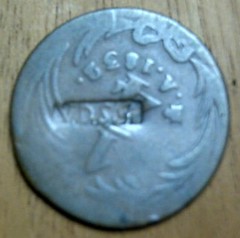

Query: A Jacobean Loyalty Medal?
Jim Bulmer writes:
There were a couple of good articles on Gunmoney and the Jacobites last week, so I thought I could ask about this piece which I bought in Dublin about 15 years ago (size is 33mm). What puzzles me about it is the Military style brass mounting....A Jacobean Loyalty Medal of sorts? Cheers
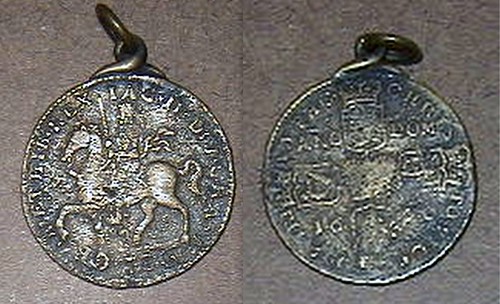
Dave Hirt at Kolbe-Fanning Lot Viewing Baltimore 2014

To read the earlier E-Sylum article, see:
WAYNE'S NUMISMATIC DIARY: NOVEMBER 2,
2014 (www.coinbooks.org/esylum_v17n45a26.html)
MORE NUMISMATIC REMEMBRANCES OF EDGAR ALLAN POE
Dave Alexander writes:
The artist who created the Monnaie de Paris medal of Edgar Allan Poe was Annette Landry (born 1907). She placed elements of Poe's poetry and prose on her reverse, notably references to Annabelle Lee and Ulalume. The corbeau or raven is the mysterious bird with the one-word vocabulary, "Nevermore."
The Hall of Fame for Great Americans (HOF) Poe medal by Michael Lantz was an artistic triumph with amazingly high relief. Little known to many of today's collectors, the HOF series was an artistic triumph.
Scott Miller writes:
Regarding medallic representations of Edgar Allan Poe, there is also a 1909 bronze plaque published by the Grolier Club by Edith Woodman Burroughs
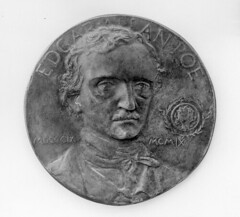 Grolier Club Memorial of Edgar Allen Poe
Grolier Club Memorial of Edgar Allen Poe
Edith Woodman Burroughs (American, Riverdale, New York 1871–1916 Flushing, New York)
Date: 1909
Medium: Bronze
Dimensions: Diam. 7 in. (17.8 cm)
Classification: Sculpture
Credit Line: Gift of R. T. Haines Halsey, 1909
Accession Number: 09.116
For more information, see:
Grolier Club
Memorial of Edgar Allen Poe
(www.metmuseum.org/collection/the-collection-online/search/14676)
EDGAR ALLAN POE GROLIER CLUB PLAQUE, 1911. Storer 2009. 178mm. Cast Bronze. Edith Woodman Burroughs, Sc. Cast by Roman Bronze Works, NYC. (Edge incused R.B.W./ N.Y.) EDGAR ALLEN POE above a front facing bust of Poe dividing the Roman numeral dates of 1809 and 1909. The seal of the Grolier Club is in the middle right field.
According to the records of the club, 277 copies were cast in bronze and 3 in silvered. (G)
PORTRAIT PLAQUE OF EDGAR ALLEN POE, 1913. 7" . Cast Bronzed White metal. Jeno Jusko, Sc. (Metal Products Mfg. Co., NYC. Mounted on a 9 1/4 x 12” wooden board. Here is a handsome high relief front facing bust of the famous author; his facsimile signature in the left field.
This is one of thirty three medallic plaques issued by Thomas Elder in a series he entitled "MEDALLIONS OF "THE IMMORTALS." The medallions, all of which came from the talented hand of Jeno Juszko, were made of "Corinthian bronze" (actually bronzed white metal) and were issued "solidly riveted to handsome solid walnut panels." They were made in three sizes; 13" mounted on a 16x19" panel ($10.00); 7", mounted on a 9 1/2 x 12" panel ($5.00) , and 4" on a 6 1/2 x 8 1/2" panel ($1.50) .
EDGAR ALLEN POE PLAQUETTE, 1988. 126 x 149.5mm. Bronze. Alex Shagin, Sc. This intriguing work is shaped like an open book with a haunting portrait of Poe on the left page and his name, “Edgar/ Allen/ POE on the right. The reverse is enigmatic. A brick wall is shown on the left with the inscription OPUS/ARTUM at lower left. A manacled hand with a chain leading to the bars of a cell is depicted on the right. We asked Mr. Shagin for its meaning and he replied, “mini-monument.” “The face, the hand… you guess the rest.”
Our guess is that the reverse is as allusion to Poe’s The Pit and the Pendulum” Shagin states that he has sold “about 40” of these.
To read the earlier E-Sylum article, see:
NUMISMATIC REMEMBRANCES OF EDGAR ALLAN
POE (www.coinbooks.org/esylum_v17n45a22.html)

HARVEY STACK ON BOOKS AND THEIR VALUE, PART 2
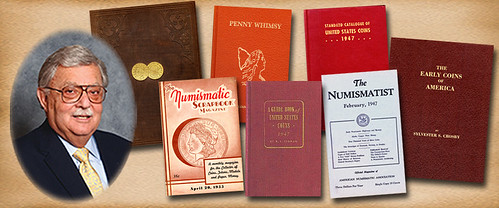
When Stack’s moved from 23rd Street to West 46th Street, then to our location on West 57th Street, the shop had a numismatic library that became the envy of every dealer. It had early books, pamphlets, auction catalogs, manuscripts, and photographs -- the reference sources needed for Stack's to produce auction catalogs and price lists for our clients. Those who came to visit our various locations were offered free use of the library material we had assembled. Thus we were not only responsible for building major collections and developing new collectors, but we could also supply references needed by collectors to guide their collecting endeavors.
Stack's retail store always had a number of shelves devoted to the sale of books and albums. These were appealing to collectors as well as people who were looking for a coin-related gift rather than a coin. A book or album could fit this bill and they enhanced our retail sales.
From the 1950s through the end of the 20th-century, literature and albums were very affordable. You could get the current edition of A Guide Book of United States Coins for $1.95. Hardbound Whitman coin albums for storing coins by date and mint could be bought for 25 cents. Deluxe albums made by National Coin Album Co. (owned by Wayte Raymond) and later by Meghrig Co. -- featuring loose-leaf pages, with cellophane slides to see both sides of the coin) -- sold for $1.50 for the album and 80 cents for each page. Each page measured 5-1/2 by 8 inches and was imprinted for the dates and mints needed for a collection. With a full stock of albums, pages and reference books, we had opportunities for multiple-item retail sales. Quite often the pages invited buyers to purchase a few coins to start filling in the empty holes. Then the challenge was to complete the album or page, often resulting in more visits to the store where a collector could learn more and more, often moving on to other specialties.
Two books that always sold tremendously well were the current edition of A Guide Book of United States Coins (as mentioned above, a very good deal at $1.95) and a book for youngsters entitled Nails to Nickels for $3 or so. The latter was designed to attract children to the hobby and featured great illustrations and stories to encourage them to become the collectors of the future
In Part 3 I will talk more about the current situation with regard to numismatic publications and why I think coin literature is still important.
To read the earlier E-Sylum article, see:
HARVEY STACK ON BOOKS AND THEIR VALUE
(www.coinbooks.org/esylum_v17n45a06.html)
1859 FOOTE SALE INSCRIBED TO LEDYARD HODGE
I wanted to let you and the rest of the E-Sylum readers know that I have found an original copy of Cogan's sale of the Foote Collection of March 7-14, 1859. The catalog is complete and is hand written with prices realized. This is not an Attinelli reprint. It also has a great inscription that reads "Mr. J Ledyard Hodge with compliments of C. B. Foote Oct 1859".
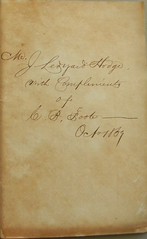
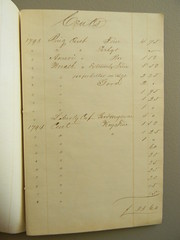
TWO ORIGINAL CONFEDERATE HALF DOLLARS COME TO MARKET
One of the most remarkable things about a truly remarkable coin, the 1861 Confederate half dollar, is that not a single example sold at auction until October 2003. Even private transactions were rare; none have been known to have occurred since the 1970s.
Rarity alone (four examples are known) probably cannot account for the infrequency of the coin’s appearance in the marketplace. Examples of the 1913 Liberty Head 5-cent coin, five known, sell with some regularity. Two examples of that coin have made three auction appearances in the past five years..
This long history of infrequent availability is what makes the twin announcements from the nation’s two biggest rivals in the numismatic auction business — Stack’s Bowers Galleries and Heritage Auctions — that each will offer an example for sale in the first quarter of 2015 truly remarkable.
One has to look back more than a century, to the period from 1910 to 1912, to find a time when two pieces (the only ones then known) were offered for sale in close proximity.

Ford-Partrick specimen
In January, Heritage Auctions will offer the coin currently owned by Donald G. Partrick, whose ownership of the piece was publicly revealed only on Oct. 30. That is when Heritage announced that coins from his collection would begin appearing at auction in 2015.
Partrick’s coin is the former John J. Ford Jr. specimen, which in October 2003 became the first original Confederate half dollar sold at public auction. That coin brought $632,500 in Stack’s 2003 sale.
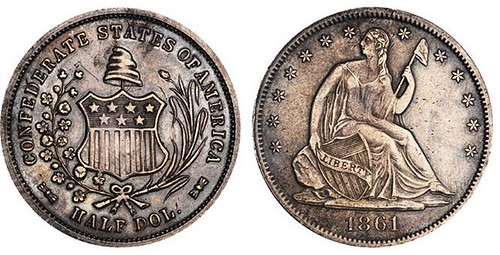
New Orleans specimen
The coin being offered by Stack’s Bowers Galleries in March 2015 disappeared between its striking in 1861 and its reappearance in 1970, when it surfaced in New Orleans. Until now, that example has never been offered at auction.
The other two examples of the coin are in institutional collections — the American Numismatic Society holds one, as does the Eric P. Newman Education Foundation.
To read the complete article, see:
Two original Confederate half dollars will make history in early 2015 with auctions
(www.coinworld.com/insights/two-confederate-half-dollars-in-two-auctions-in-early-2015.html)

CIVIL WAR TOKENS OF ALLEGHENY CITY
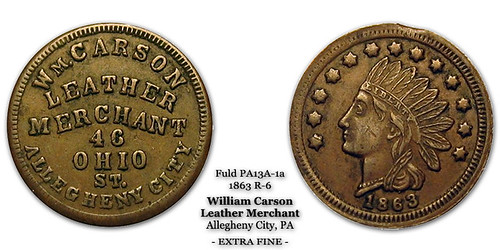
Allegheny City was located just across the Allegheny River from downtown Pittsburgh, PA. It is now known simply as “the North Side” (See figure 1). Allegheny was long ago absorbed by the growing city of Pittsburgh, but its memory lives on. The Civil War Tokens of six merchants are part of the numismatic legacy of Allegheny City. This article is a short history of their town.
The U.S. Census of 1810 recorded approximately 450 residents of Allegheny Town. They were mostly Presbyterian settlers who farmed and manufactured such items as glass and rope. An 1825 visitor described “… a little village called Allegheny Town, laid out upon a grand scale, but on account of the proximity of Pittsburgh, it will with difficulty attain any importance.”
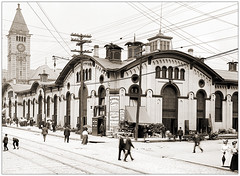 Abraham Lincoln stopped in Allegheny City on the
way to his inauguration in 1861. The City continued to grow as its mills turned out valuable
materials for the war effort. Civic improvements continued even as the war raged in the South. In
1863 the City acquired its first steam fire engine, and dedicated a new Market House, called the
finest in the nation.
Abraham Lincoln stopped in Allegheny City on the
way to his inauguration in 1861. The City continued to grow as its mills turned out valuable
materials for the war effort. Civic improvements continued even as the war raged in the South. In
1863 the City acquired its first steam fire engine, and dedicated a new Market House, called the
finest in the nation.
In 1864 a Sanitary Fair was held to raise money for the “subsistence and hospitalization of Union Soldiers and their dependents.” The organizers requested donations of things which could be “eaten, worn, sold, or were curious to look at.” A new City Hall building was nearly complete, and it was decided to tear down the old Town House ahead of schedule to make room for the Fair. City Council declared that a photograph of the historic structure be taken and 200 copies be given to the Fair, presumably to be sold as souvenirs.
The Sanitary Fair opened on June 1st, 1864. Buildings included Floral Hall, Exhibition Hall, Mechanics Hall, Ladies Bazaar, and the Refectory. The Fair raised $363,000 for the soldiers.
Pittsburgh politicians long yearned to control Allegheny City. Allegheny City, of course, clung tightly to her independence, and would have no part of her crowded neighbor across the river. As early as 1867 Pittsburgh moved to incorporate outlying districts.
By 1905 however, the political climate began to change. Proponents of Pittsburgh’s annexation scheme had the ear of the new Governor, Samuel W. Pennypacker. A bill was rushed to the State Legislature, and passed on February 7, 1906. The bill allowed for two municipalities to merge if agreed to by a majority of the ENTIRE population of the two areas. An election was quickly held, and Pittsburgh having a far greater population than its neighbor, the outcome was inevitable. The vote was two-to-one in favor of annexation, despite the wishes of 70% of Allegheny City voters.
Allegheny was proud of her existence, and her death struggles were severe. A series of appeals went all the way to the U.S. Supreme Court; all failed. On December 6, 1907, by order of the Supreme Court of Pennsylvania, the consolidation was complete. Allegheny City was no more.
To read the complete article, see:
Allegheny City and Its Tokens – Gone But Not Forgotten
(www.novanumismatics.com/numismatics-ghost-towns/allegheny-city-and-its-tokens-gone-but-not-forgotten/)
HAND-ENGRAVED CONFEDERATE DAVIS FLIGHT MEDAL
And speaking of the Civil War, this note came in just today from web site visitor Kent Whiting of Helena, MT. He writes:
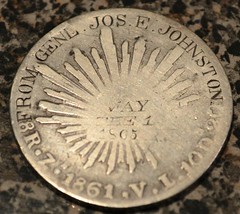 I recently read with great interest the query by Nat
Kaminski in The E-Sylum: Volume 17, Number 13, March 30, 2014 regarding his engraved 8 reale
coin. I have a similar engraved 8 reale coin with a less elaborate engraving. It says simply “FROM
GENL JOS. E. JOHNSTON MAY THE 1st 1865”. The date on this coin is quite late, given that most all
of the troops were paid on April 26th (according to the follow-up letters in The E-Sylum).
May 1st is 5 days after the Greensboro troops were paid. I have attached a photograph of the coin
in hopes one of your readers may have some information on this coin.
I recently read with great interest the query by Nat
Kaminski in The E-Sylum: Volume 17, Number 13, March 30, 2014 regarding his engraved 8 reale
coin. I have a similar engraved 8 reale coin with a less elaborate engraving. It says simply “FROM
GENL JOS. E. JOHNSTON MAY THE 1st 1865”. The date on this coin is quite late, given that most all
of the troops were paid on April 26th (according to the follow-up letters in The E-Sylum).
May 1st is 5 days after the Greensboro troops were paid. I have attached a photograph of the coin
in hopes one of your readers may have some information on this coin.
To read the earlier E-Sylum articles, see:
EXHIBIT: HAND-ENGRAVED CIVIL WAR SILVER
COINS (www.coinbooks.org/esylum_v14n01a14.html)
QUERY: ENGRAVED CONFEDERATE CAMP MARION
COIN INFO SOUGHT (www.coinbooks.org/esylum_v17n13a15.html)
MORE ON ENGRAVED CONFEDERATE DAVIS FLIGHT
MEDALS (www.coinbooks.org/esylum_v17n15a21.html)
ALAN WEINBERG ON DAVIS FLIGHT MEDALS
(www.coinbooks.org/esylum_v17n16a20.html)
PETER BERTRAM ON DAVIS FLIGHT MEDALS
(www.coinbooks.org/esylum_v17n17a12.html)
ON COMPARING HAND-ENGRAVING STYLES
(www.coinbooks.org/esylum_v17n18a07.html)
CHINESE GOLD-PLATED TUNGSTEN BULLION COIN COPIES

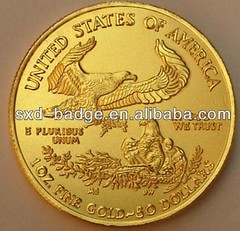
First kind of customers are those who really like to collect .Our 60 microns gold plated tungsten gold coin (bar) contains several grams gold, having the collection value.
Second kind of customers are those who want to send gift and present to friends owning good taste. But the true gold coin (bar) is so expensive that we can’t pay for it. Do not worry. Come to me. Our product is the same as the original. Expert cann’t distinguish them by acid test, X-ray test or scratch test, not mention to your friends. You would pay half of the original and give your friend a gift worth 1300USD.
Last but not lest, they are those who really want to make a big money. Because our gold coin (bar) is easy to resale. There is no doubt that it is very hot and popular in marketing , now. You can use it to do many meaningful thing.
2. why are our product the most expensive in marketing, as an imitation tungsten gold coin (bar)?
Question 1:Our tungsten gold coin (bar)is the same as the original in dimension and weight. And the deviation between our product to the true gold coin(bar) is only 0.01 mm ,which would be acceptable by any test institution.
Question 2: As mentioned above, we gold coin (bar) can pass any real gold test, for example acid test, X-ray test or scratch test etc.
Question 3:The material of our product is tungsten and gold. As you know, the densities of tungsten and gold are similar. So we can guarantee the weight of our coin (bar) is the same as the original.
What kinds of product do we have?
Tungsten gold coin:
1 oz 22k/33.93 grams Liberty tungsten gold eagle coin(2001,2003) 32.70*2.87mm 1 oz 24k/31.11 grams Elizabeth tungsten gold coin (2004) 30*2.8mm 1 oz 22k/33.93 grams South Africa tungsten goldcoin (1975/78/88/89) 32.65*2.54mm
Tungsten gold bar:
1 oz 24k/31.11 grams Royal Canadian tungsten gold bar 50*29*1.5mm
1 oz 24k APMEX Gold bar in assay 50*28*1.5mm
If you want other coins or bars, we can make it for you. OME is welcome.
Krugerand Copies
Q: Is the product magnetic?
A: No, the coins and bullions are of no magnatic at all
Q: Can these coins and bars pass gold tests?
A: Yes, the thickness of the gold coating can be customized, 60 microns gold coated can pass gold
tests.
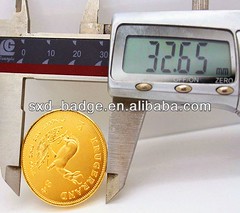
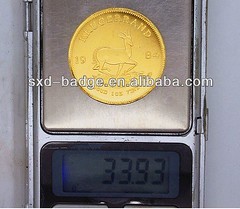
Philip adds
We saw an “1887 gold £5” today that could well have been from this source. These are very dangerous, Harold has trawled U-tube comments and it appears that the only way, currently, of distinguishing genuine from fake is the old fashioned method of “ringing” a coin. The fakes being sintered Tungsten rather than truly solid don’t ring in the way a gold coin should. I haven’t heard it demonstrated however.
To read the complete article, see:
1 troy oz gold plated tungsten coin
(sxd-badge.en.alibaba.com/product/1938470737-214160299/1_troy_oz_gold_plated_tungsten_coin.html)
22k gold plated replica gold krugerrand
(sxd-badge.en.alibaba.com/product/628014408-214160299/22k_gold_plated_replica_gold_krugerrand.html)
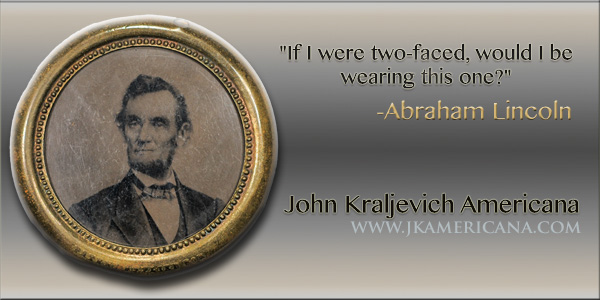
MORE ON THE CHIEF THREE FINGERS INDIAN PEACE MEDAL
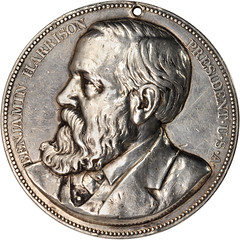
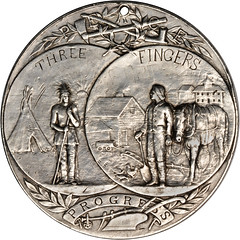
The piece was recently discovered far from its original context. However, it fortunately bears the name of a Native American owner, engraved on the reverse, allowing for identification of the original recipient and the reason it was awarded. “As soon as I saw the images of the medal, I knew it was special and I was eager to research it in the hopes that a great story would unfold, and that it did,” said John Pack, executive director of consignments, who researched and catalogued the medal for sale.
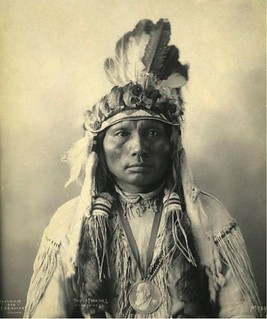 The coin was one of
18 issued to members of the Southern Cheyenne and Arapahoe tribes who were considered helpful in
the consummation of the sale of a vast portion of Indian Territory to the United States for $1.5
million in October 1890. This medal was awarded to Buffalo Meat, of the Southern Cheyenne, and
later became the property of his contemporary, Three Fingers, a Chief of the same people. Three
Fingers’ name is engraved on the reverse in similar style to that seen on three other Benjamin
Harrison medals. “It is very rare but a great pleasure to be able to assign an original owner to
one of these medals,” stated Pack.
The coin was one of
18 issued to members of the Southern Cheyenne and Arapahoe tribes who were considered helpful in
the consummation of the sale of a vast portion of Indian Territory to the United States for $1.5
million in October 1890. This medal was awarded to Buffalo Meat, of the Southern Cheyenne, and
later became the property of his contemporary, Three Fingers, a Chief of the same people. Three
Fingers’ name is engraved on the reverse in similar style to that seen on three other Benjamin
Harrison medals. “It is very rare but a great pleasure to be able to assign an original owner to
one of these medals,” stated Pack.
It is believed that there were only 27 of these silver medals struck in 1890 and 1891, and they were the last ones made for official distribution amongst Native Americans. These brought closure to a tradition that began in the United States with President Washington’s administration, though his issuance of such medals was simply a continuation of the tradition established by the Spanish, French and British who issued similar medals on behalf of their kings in the colonial period. This medal is a new discovery and one of only seven known to survive today.
The medal will be available for lot viewing at upcoming Stack’s Bowers Galleries auctions, at the company’s Irvine, Calif. corporate headquarters (January 19-28, 2015), and its New York City gallery (February 3-6, 2015). For more information or to schedule a lot-viewing appointment, please call 800.458.4646 (West Coast) or 800.566.2580 (East Coast), or email info@stacksbowers.com.
To read the earlier E-Sylum article, see:
THE CHIEF THREE FINGERS MEDAL
(www.coinbooks.org/esylum_v17n45a18.html)
SELECTIONS FROM NOBLE NUMISMATICS SALE 107
Lot 599: Australia Halfpenny GEORGE V, 1923.
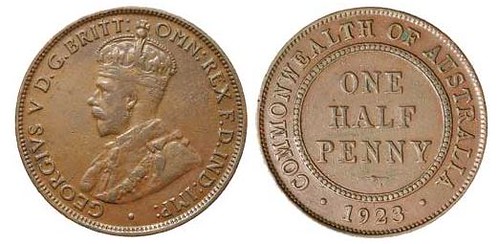
To read the complete lot description, see: www.noble.com.au/auctions/lot?id=328098
Lot 796: Australia Token HENRY, Samuel, Deloraine penny, 1857
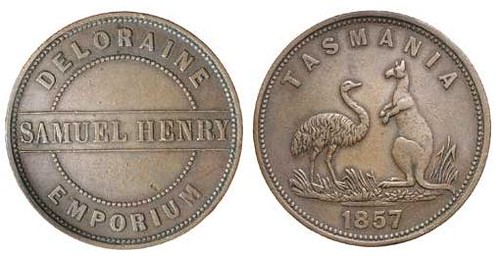
To read the complete lot description, see: www.noble.com.au/auctions/lot?id=328295
Lot 900: Australia Token: LANE, Joseph & Son, Birmingham halfpenny, undated
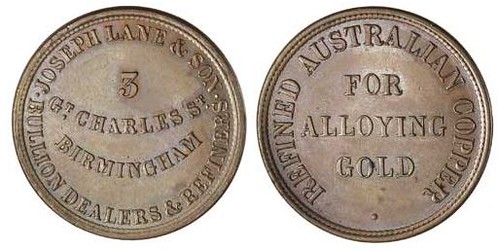
To read the complete lot description, see: www.noble.com.au/auctions/lot?id=328399
Lot 1298: NEW SOUTH WALES, fifteen pence or dump, 1813
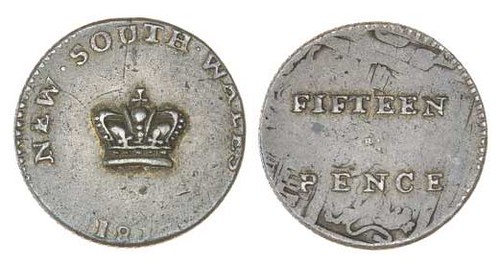
To read the complete lot description, see: www.noble.com.au/auctions/lot?id=328797
Lot 1310 ADELAIDE POUND, second type, 1852
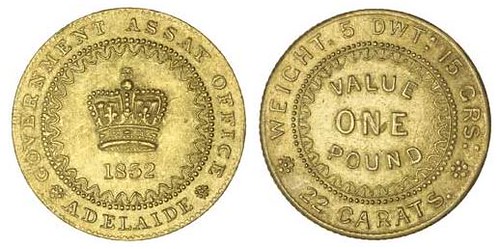
To read the complete lot description, see: www.noble.com.au/auctions/lot?id=328809
Lot 2477: RESERVE BANK OF NEW ZEALAND, L.Lefeaux, one pound, 1st August 1934
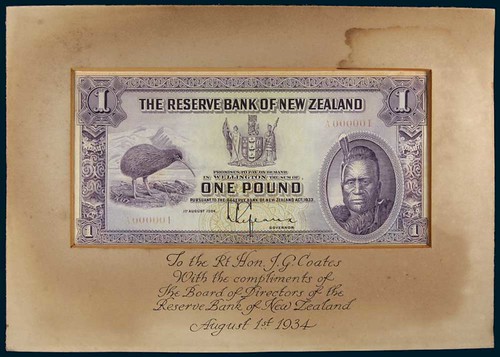
RESERVE BANK OF NEW ZEALAND, L.Lefeaux, one pound, 1st August 1934, A 000001 (P.155). Attached by the edges to a cardboard frame with an inscription 'To the Rt. Hon. J.G. Coates/With the compliments of the Board of Directors of the Reserve Bank of New Zealand/August 1st 1934', minor foxing and some fading having been in a frame on the wall of the family home, otherwise extremely fine and a unique number one note.
To read the complete lot description, see: www.noble.com.au/auctions/lot?id=329976
To view the numismatic literature lots, see:
www.noble.com.au/auctions/search?sale=107&c=5695
SOME INTERESTING MEDALS: NOVEMBER 9, 2014
Bressett 2012 Rittenhouse Society Medal
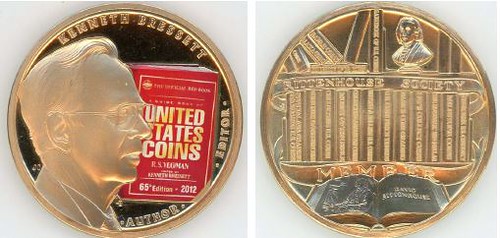
KENNETH BRESSETT 50TH ANNIVERSARY AS EDITOR OF THE RED BOOK, 2012. 56mm. Bronze. With a red-gold image of the Red Book pad printed on the obverse. Joel Iskowitz, Des. Luigi Badia, Mod. (MACO). The obverse bears the portrait of Kenneth Bressett to the right and the inscription, KENNETH BRESSETT AUTHOR EDITOR. Pad printed in red and gold is the cover of the 65th edition of The Guide Book of United States Coins – universally known as the “Red Book.” The reverse is quite similar to that on the Eric Newman 100th birthday medal and bears a double shelf of books with the names of all of Bressett’s works which he authored or for which he was editor. On the top shelf is a statuette of David Rittenhouse and inscribed on a banner below, the name, RITTENHOUSE SOCIETY. In the exergue is an open book with an outline portrait of Rittenhouse – from the 1796 painting by Charles Wilson Peale – his name on the facing page. MEMBER is inscribed above.
The Rittenhouse Society was founded in 1960 for sharing of information and goodwill among numismatic researchers. Members are elected, generally at the rate of one new member per year, in recognition of their past contributions to the body of American numismatic scholarship. The founding members were: Q. David Bowers, Walter Breen, Eric Newman, Ken Bressett, Grover Criswell, Dick Johnson, and Ken Rendell.
To our knowledge, this is the only medal struck in the United States utilizing the pad printing process. How appropriate it is that it should be one that involves the Red Book! Only 50 of these medals were struck in bronze. There were no strikes in gold or silver. $65.00
Anthony De Francisci Creation Medal
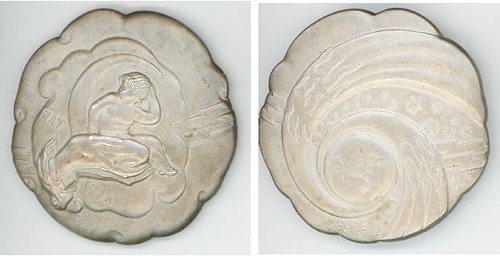
CREATION. SOCIETY OF MEDALISTS ISSUE #12, 1935. 73mm. Silver Plated Bronze.. Anthony De Francisci, Sc. About Uncirculated. Obverse: Creation. Reverse: Swirling Universe. De Francisci states, "In choosing the subject of "Creation" for this medal I tried to crystallize in a few inches of space the general belief held by astronomers the world over that out of the gigantic masses of whirling matter, dotting various sections of our visible firmament, worlds come generally into being." "The advent of life, either in its rudimentary or complex organism, is based on the hypothesis that life could evolve and endure on all planets receiving heat and light from a central orb." Only 100 medals were struck in silver. $65.00
THE BOOK BAZARRE
HOWARD BERLIN VISITS TALLINN, ESTONIA
A previous article in The E-Sylum was about my visit to two museums in Vilnius. Leaving Vilnius after four days, I flew to Tallinn, Estonia with a brief stopover to change planes in Riga, Latvia.
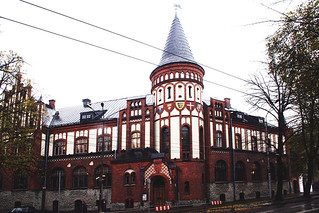 In Tallinn I visited the country’s central bank museum,
the Bank of Estonia Museum, where I was met by Siiri Ries, the museum’s manger, who guided me
around the museum’s exhibits. Siiri had also provided information for my book, so seeing her and
the museum in person was special.
In Tallinn I visited the country’s central bank museum,
the Bank of Estonia Museum, where I was met by Siiri Ries, the museum’s manger, who guided me
around the museum’s exhibits. Siiri had also provided information for my book, so seeing her and
the museum in person was special.
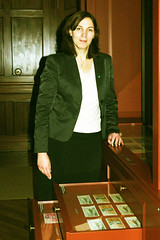
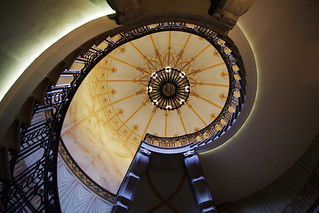
Siiri Ries; Bank of Estonia Museum spiral staircase
The museum is in the former building of the bank of the Credit Society of the Estonian Knighthood. Built in 1904, at the time it represented the first modern purpose-built bank in Tallinn and was fully transferred to the Bank of Estonia in 1998. Renovations in 2010 allowed the museum to occupy approximately 4,000 square feet (370 square meters). There are three exhibition halls: Aadlisaal (Hall of Nobility), Peasant, and the Treasury Center. All have a little piece of hidden history in each one. Computer animation is used to explain the meaning of money, the role of the Viking trade, and Estonian participation in world trade in the 9th-10th centuries.
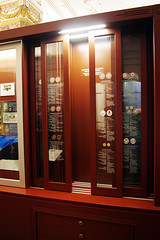 On display are the currencies that were
used in Estonia before it became an independent republic in 1918. The Museum also displays every
banknote and coin issued since independence, including the initial promissory and credit notes to
the first actual currency banknotes denominated in the original marka system until 1940. This is
followed by occupations by the Russians (1940-1941, and 1945-1990) and the Germans (1941-1944),
after which independence from the Soviet Bloc allowed the 1992 monetary reform that established the
Eesti kroon from 1992 to 2010. Multimedia is displayed in Estonian, English, and Russian, while
exhibit texts are in both Estonian and English.
On display are the currencies that were
used in Estonia before it became an independent republic in 1918. The Museum also displays every
banknote and coin issued since independence, including the initial promissory and credit notes to
the first actual currency banknotes denominated in the original marka system until 1940. This is
followed by occupations by the Russians (1940-1941, and 1945-1990) and the Germans (1941-1944),
after which independence from the Soviet Bloc allowed the 1992 monetary reform that established the
Eesti kroon from 1992 to 2010. Multimedia is displayed in Estonian, English, and Russian, while
exhibit texts are in both Estonian and English.
Visitors can also see a historic gold bar of the Bank of Estonia from 1922 that was part of the reserves backing the kroon during the first Republic of Estonia and also during re-independence. The historic gold bar was delivered to Estonia in December 2011 by the Federal Reserve Bank of New York.
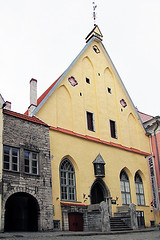 While in Tallinn, I was fortunate to have
time to also visit the Estonian History Museum, with Ms. Ries providing me with the name and e-mail
of its curator, Dr. Ivar Leimus. This museum has an exhibition, titled, "Striking it rich?!
Money in Estonia Through the Ages.” It occupies a small vaulted room off from the museum’s entrance
foyer, called the “Excise Chamber,” which was built between the Great Guild Hall and an adjacent
house in 1551. The exhibition, started about three years ago by Dr. Leimus, provides an overview of
the currencies that have been used in Estonia’s history. There are six major displays and they are
supplemented with specimens contained in over 70 pull-out drawers. In addition, there are three
different interactive video informational displays with Dr. Leimus narrating in Estonian with
English subtitles.
While in Tallinn, I was fortunate to have
time to also visit the Estonian History Museum, with Ms. Ries providing me with the name and e-mail
of its curator, Dr. Ivar Leimus. This museum has an exhibition, titled, "Striking it rich?!
Money in Estonia Through the Ages.” It occupies a small vaulted room off from the museum’s entrance
foyer, called the “Excise Chamber,” which was built between the Great Guild Hall and an adjacent
house in 1551. The exhibition, started about three years ago by Dr. Leimus, provides an overview of
the currencies that have been used in Estonia’s history. There are six major displays and they are
supplemented with specimens contained in over 70 pull-out drawers. In addition, there are three
different interactive video informational displays with Dr. Leimus narrating in Estonian with
English subtitles.
The exhibition, documenting the money used in the former Livonia up to the present-day independent Estonia, covers six time periods: Viking Age, 800-1200 AD; Middle Ages, 1200-1561 AD; Early Modern Period, 1591-1710 AD; Late Modern Period, 1710-1800 AD; Late Modern Period, 1800-1918 AD; and Contemporary History, 1918-2011 AD.
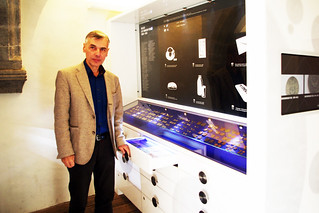
Estonian History Museum numismatic curator Dr Ivar Leimus
Before heading home, I flew to London for an overnight stay. While there I met up with Michael Alexander who writes for the on-line sites CoinNews and Coin Update. Besides reporting on numismatic news, Michael also occasionally visits and writes about numismatic museums. Michael has visited the Tallinn museums several times and I was able to pass on regards from Siiri and Ivar. We traded some travel “war stories” over faux milkshakes at a McDonalds on High Street Kensington.
Later that day I also met up with a nephew and his girlfriend who both live in London’s Hampstead Village. We had dinner at Goodman Restaurant, a steakhouse in on Maddox Street in the Mayfair district. This time, I got hit with the bill – £238 ($381) for a party of three! I was debating between paying with five crisp, new £50 notes I recently got from the Bank of England or using plastic. Payment using the credit card won, thereby allowing me to collect my frequent flyer miles on British Air.
To read the earlier E-Sylum article, see:
HOWARD BERLIN VISITS VILNIUS,
LITHUANIA (www.coinbooks.org/esylum_v17n45a27.html)
SCHOOL COLLECTION DONATED TO SMITHSONIAN
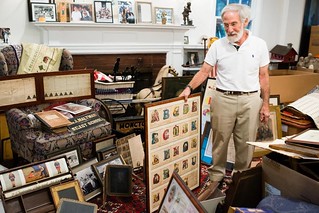 Lodish’s Bethesda living room was jammed with
artifacts related to the history of education. So was his basement, and his dining room and his
garage. Objects were piled on the floor, on tables and chairs, leaning against the walls, propped
on the mantelpiece.
Lodish’s Bethesda living room was jammed with
artifacts related to the history of education. So was his basement, and his dining room and his
garage. Objects were piled on the floor, on tables and chairs, leaning against the walls, propped
on the mantelpiece.
“Take everything!” Lodish joked that his wife might say. “And take my husband!”
Although they can’t take everything, the experts from the Smithsonian Institution’s National Museum of American History have been sifting through Lodish’s astounding collection of school memorabilia for the best things.
“It’s a very big deal,” said Debbie Schaefer-Jacobs, the associate curator in the museum’s division of home and community life. The collection is so broad that it’s being distributed among several museum divisions.
The retired head of the Sidwell Friends Lower School, Lodish, 68, has been collecting for decades: desks, bells, spellers, readers, primers, blackboard slates, report cards, samplers, merit cards, police cutouts and outhouse seats.
Lodish had exhibited part of his collection at Sidwell’s upper school late last year and thought it would be a good idea to share with others.
“I just felt that many, many more people would be interested in what I’ve collected,” he said. “And I want more people to see it.”
“Especially kids,” he said. “I think they would be very interested if they’re, like, in the fourth, fifth or sixth grade” to see school life from 100 years ago.
The museum said it plans to take about 800 items, or two-thirds of the collection. Some items already have been transferred. But there is much more.
Lodish said he attended auctions, went to flea markets and kept an eye on eBay. Most of his items date from the 1800s and early 1900s.
He has already turned over to the museum some rare 18th-century “horn books” — small wooden paddles bearing tiny lessons on parchment covered with a transparent film of animal horn to protect them.
“It’s like having a baby that grows up,” he said of his treasures. “Now they’re on their own. I love this stuff. But I love much, much, much more that other people love it now.”
To read the complete article, see:
A is for abacus, O is for outhouse seat: Educator donates collection to Smithsonian
(www.washingtonpost.com/local/from-a-living-room-to-the-smithsonian-a-vast-collection-of-rare-school-memorabilia/2014/11/02/22eec070-5dfc-11e4-8b9e-2ccdac31a031_story.html)
EXHIBIT: THE FAKES, LIES AND FORGERIES
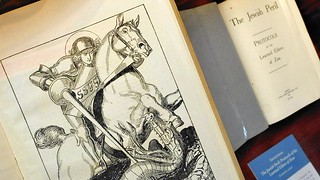 The dozens of charlatans, schemers and impostors on
display in "Fakes, Lies and Forgeries," an entertaining new exhibit running at the George
Peabody Library, went to great lengths to conceal their guile, from concocting a bogus description
of Jesus Christ to burying fake marble hieroglyphics that "proved" that Noah's ark
beached in Italy.
The dozens of charlatans, schemers and impostors on
display in "Fakes, Lies and Forgeries," an entertaining new exhibit running at the George
Peabody Library, went to great lengths to conceal their guile, from concocting a bogus description
of Jesus Christ to burying fake marble hieroglyphics that "proved" that Noah's ark
beached in Italy.
In the age of Photoshop, James Frey and various forms of Internet chicanery, never has an exhibit on the fine art of lying been more timely. Now Baltimore is poised to become the epicenter of forgery studies internationally, thanks to a recent acquisition of what arguably is the world's largest collection of historically significant phony documents.
"It takes a lot of intellect, creativity and imagination to pull off a forgery," said Earle Havens, the library's curator of rare books and manuscripts and the exhibit's co-curator. "Forgery appeals to a fundamental aspect of human nature — our predilection to deceive. This is the naughty bits of history."
About 70 of the most famous literary and historical forgeries are on view, dating from roughly the 12th century to the middle of the 20th. Each of the flim-flam men who created them succeeded, at least for a time. A few changed history.
"Sometimes, the motivation for the forgeries was to do what we're doing now — talking about them 400 years later," Havens said. "If you can't get famous for the genius of your poetry, maybe you can get famous for being one of the best liars in the history of the world."
The exhibit, which runs through Feb. 1, is culled from a 1,700-item collection of literary and historical counterfeits and frauds amassed by a London couple over half a century. The Fakes, Lies and Forgeries," was partly sold and partly donated to the Johns Hopkins University in 2011 by Arthur and Janet Freeman.
Anthony Grafton, a history professor at Princeton University and the author of the book "Forgers and Critics," described the holdings as "the greatest collection of its kind in the world."
"There's nothing like it anywhere else," Grafton said.
"Great institutions like the British Library have lots of forgeries, but they're spread throughout the collection. Here, the books are together and they kind of talk to each other when you're working on them. In the future, anyone who's seriously interested in studying forgery will have to go to Baltimore."
Bata Kindai Amgoza Ibn LoBagola
Consider the case of the man who called himself "Bata Kindai Amgoza Ibn LoBagola" — in
reality, Baltimore's own Joseph Howard Lee, an impoverished African-American gay man coping
with a double whammy of discrimination at the turn of the 20th century.
So he decided to become someone else. In particular, LoBagola decided to become a black Jewish prince and self-proclaimed former savage who hailed from a remote part of Africa. Oh, and did LoBagola mention that he also was descended from one of the lost tribes of Israel?
In 1930, he persuaded a leading American publisher, Alfred A. Knopf, to bring out his life story; a copy of that book is in the exhibit.
"He decided to emancipate himself," Havens said. "There's something very American about being rebellious and chafing against restriction."
Protocols of the Learned Elders of Zion
On display is a copy of the first German edition of the "Protocols of the Learned Elders of
Zion," which claimed to reveal a Jewish conspiracy for world domination and which was used to
justify the Holocaust. Though the inflammatory pamphlet was discredited almost immediately, it
spread rapidly throughout Europe and America.
"It's an ugly story," Havens said, "a terrible, pernicious lie that caused the deaths of millions of people."
To read the complete article, see:
Exhibit
of forgeries shows off unprecedented collection at Peabody Library
(www.baltimoresun.com/entertainment/arts/bs-ae-peabody-forgery-20141025-story.html)

PERU'S 10 SOLES BANKNOTE TURNS GREEN
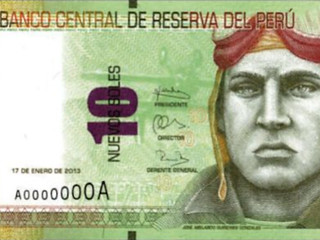 The Central Reserve Bank (BCR) recently presented a new
version of the 10 soles bill, although from first glance it would be hard to tell.
The Central Reserve Bank (BCR) recently presented a new
version of the 10 soles bill, although from first glance it would be hard to tell.
While the change may not appear to be drastic, the renovated bill is now painted a stronger green which will ideally help for better and easier identification.
“Now its predominant color, green, is more intense and differentiated from other members of the current family of banknotes,” said BCR in a statement.
According to El Comercio, the new bills will be integrated into circulation along with the current 10 soles bills starting Wednesday.
The news agency points out the following attributes to differentiate the old from the new, and the real from the fake:
- The Watermark should clearly show intense dark contours.
- Upon tilting the banknote the figure should change from fuchsia to green.
- Also, turning the ticket should reveal hidden numbers in the main figure.
To read the complete article, see:
Meet the new,
more secure S/. 10 bill
(www.peruthisweek.com/news-meet-the-new-more-secure-s-10-bill-104392)
WEB SITES PROMOTE WOMEN ON CANADIAN BANKNOTES

Canadian banknote idea - Lucy Maud Montgomery
In 2011, the Bank of Canada nixed plans to display images of prominent female activists on a new $50 bill.
It had initially planned to depict the "Famous Five," a group of women that fought to see females recognized as persons under the constitution, and Thérèse Casgrain, a feminist and the first woman ever elected to lead a political party in Canada.
They were replaced by an icebreaker, said a Toronto Star editorial.
As of 2014, no women appear on any Canadian currency, save for Queen Elizabeth II.
Merna Forster aims to change that.
The Victoria, B.C.-based creator of Heroines.ca, a website dedicated to highlighting outstanding Canadian women, started a Change.org petition last year calling on the Bank of Canada to display women on the country's money.
Current Bank of Canada Governor Stephen Poloz has said he's "absolutely open to the idea," but he was criticized earlier this month after announcing a new process for designing currency which did not address concerns about the lack of women, CBC News said.
And now Forster, whose petition has gained over 48,000 supporters (including prominent author Margaret Atwood), is stepping up her campaign.
She is preparing to launch a website, Women on Canadian Banknotes, in which people are encouraged both to sign her petition, and to come up with their own suggestions for who should appear on Canadian bills.
The tool is simple: you simply go to the website, hit "Generate your Suggestion," upload a photo, and voila, you have a Canadian $100 bill with a prominent woman's face on it.
To read the complete article, see:
'Women
On Canadian Banknotes' Seeks More Female Faces On The Country's Money
(www.huffingtonpost.ca/2014/11/04/women-canadian-money-currency-petition_n_6085464.html)
EAST GERMANY'S PHANTOM BANKNOTES
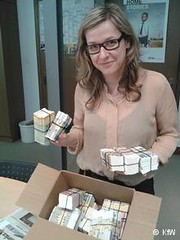 It felt a bit unreal to carry a large paper bag
full of banknotes through security at Frankfurt airport, Lysann Goldbach laughs as she tells the
story. One million marks in cash. The airport staff suspected money laundering.
It felt a bit unreal to carry a large paper bag
full of banknotes through security at Frankfurt airport, Lysann Goldbach laughs as she tells the
story. One million marks in cash. The airport staff suspected money laundering.
The 36-year-old tried to explain, but was treated with suspicion. It was only when an older security guard arrived that they believed her.
"Yes, these are East German marks" she confirmed.
Goldbach works at the state-owned KfW bank, which was formerly tasked with rebuilding the economy of Germany's east. She is the director of its historical archive, which includes the legacy of the former East German central bank, the "Staatsbank."
In the 1980s, the Staatsbank's vault contained large numbers of freshly printed 200- and 500-mark notes that never entered circulation. A banknote worth a month's salary seemed inappropriate to the communist country's leadership.
But years after the fall of the Berlin Wall, these bills kept appearing at various locations in Germany.
Where did they come from? They must surely have been stolen.
The story begins in 1991, the year after German reunification. All of East Germany's now-worthless paper money was buried in two sandstone caverns near Halberstadt, in the eastern state of Saxony-Anhalt. It was expected to slowly rot.
Following its 1994 merger with the successor to the East German central bank, the KfW became the owner of the money. It assumed it was safe in the underground facility.
But then East German banknotes started surfacing on the collectables market. Thieves had gained access to the caverns. So in a complex operation, the KfW removed the banknotes from the cavern and destroyed them in March 2002. At least it thought it had. But 200- and 500-mark East German banknotes keep appearing - like those in Frankfurt. Dealers are said to be willing to pay 15 euros per bill.
This latest batch of millions has made its way directly to the archive. Now the notes are back in a vault in Berlin in "one of the most beautiful places in the capital," she said. "We can't be much more specific than that about the location."
To read the complete article, see:
East Germany's phantom
banknotes (www.dw.de/east-germanys-phantom-banknotes/a-18001532)
THE BOOK BAZARRE
BALTIMORE BAR INSTALLS BITCOIN ATM
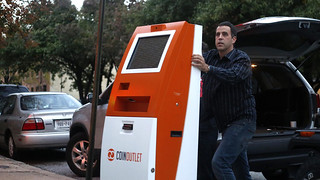 A company that plans to install as many as 100 bitcoin ATMs by
year's end installed the region's first of the machines Monday night at Fells Point bar Bad
Decisions. More are planned for Baltimore-Washington International Thurgood Marshall Airport and
Amtrak stations, Wal-Marts and 7-Eleven stores around the region.
A company that plans to install as many as 100 bitcoin ATMs by
year's end installed the region's first of the machines Monday night at Fells Point bar Bad
Decisions. More are planned for Baltimore-Washington International Thurgood Marshall Airport and
Amtrak stations, Wal-Marts and 7-Eleven stores around the region.
While usage of bitcoin is still low — even at establishments like Bad Decisions, a well-known early adopter of technology and social media — advocates hope the ATMs will make it easier for technophiles to give bitcoin a try.
"It's going to be an easy entry point for consumers to actually get bitcoins," said Josh Riddle, CEO and co-founder of Bitsie, a Baltimore startup that works with brick-and-mortar stores to help them accept bitcoin payments.
Otherwise, the virtual currency exists solely online. A public ledger system tracks who owns which bitcoins, each of which was worth about $380 as of Monday. Most bitcoin users get them by buying them on one of a host of online exchanges, or by accepting them for goods or services being sold. Bitcoin "miners" generate new bitcoins by helping to process and verify bitcoin transactions.
Bitcoin ATMs allow users to quickly use cash to buy bitcoins or to turn their bitcoins into bills. There are only about two dozen around the country; until Monday, the closest ones to Baltimore were in New York, Chapel Hill, N.C., and Columbus, Ohio.
The North Carolina-based company Coin Outlet installed the machine at Bad Decisions, a logical choice because it is the site of a regular meetup of bitcoin enthusiasts, Coin Outlet CEO Eric Grill said. But the plan is to go well beyond the bar — Coin Outlet has a relationship with Locant Services, a company that operates kiosks for payphones, ATMs and other services at 100,000 locations across the country.
Grill said the ATMs are intended both to expose a wider audience to bitcoins, and to offer it as a cheaper and easier alternative for buying bitcoins.
To read the complete article, see:
Cryptocurrency
meets cash at new bitcoin ATM in Fells Point
(www.baltimoresun.com/business/bs-bz-bitcoin-atm-20141020-story.html)
YORKSHIRE COIN HOARDS EXHIBITED ONLINE
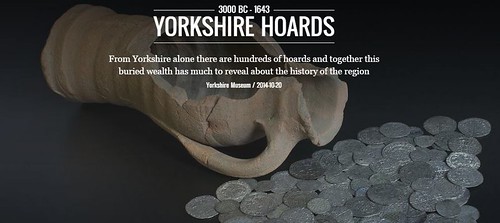
Curator’s Choice: Andrew Woods, Curator of Numismatics for York Museums Trust, on the Yorkshire Museum's collection of Yorkshire Hoards going global with Google
“The numismatic collection – money and medals – numbers over 40,000 objects and is one of the strongest in northern England.
Most of that material has been excavated with new finds coming up every year from farmers, metal detectorists and archaeologists.
A lot of that excavated material comes in the form of hoards – accumulations of wealth buried in the ground.
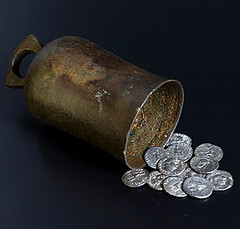
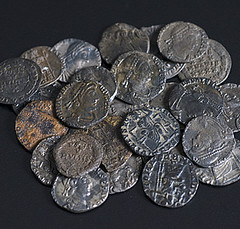
Yorkshire Hoards is a project between Google Cultural Institute and York Museums Trust looking at these hoards and what they can tell us about the history of the region.
Over the past 3,000 years, from the Bronze Age through to the 17th century, very large numbers of hoards have gone into the ground across Yorkshire.
These represented the safest way to store your wealth in a period before there were banks: ‘I know where I buried it, I can go and dig it up again at some point in the future.’
Quite why they all went into the ground is slightly more difficult. Some went into the ground, in all probability, because of unrest – times where there’s warfare see lots of hoards go into the ground.
Others may have more to do with offerings or rituals to the gods, that type of thing. The last type would be savings, gradually added to over many years.
The potential of these hoards is enormous – they can tell us about power, about belief, about ritual, all about the local and international links of the person who buried them.
“In short, they give us a window into the range of different periods across the region."
![]() Google has partnered with hundreds of museums,
cultural institutions, and archives to host the world’s cultural treasures online.
Google has partnered with hundreds of museums,
cultural institutions, and archives to host the world’s cultural treasures online.
With a team of dedicated Googlers, we are building tools that allow the cultural sector to display more of its diverse heritage online, making it accessible to all.
Here you can find artworks, landmarks and world heritage sites, as well as digital exhibitions that tell the stories behind the archives of cultural institutions across the globe.
For more information on Google Cultural Institute, see:
Google Cultural Institute
(www.google.com/culturalinstitute/about/)
To view the Google Cultural Institute online exhibit, see:
3000 BC - 1643
Yorkshire Hoards (www.google.com/culturalinstitute/exhibit/yorkshire-hoards/QRq2DoZm)
To read the complete article, see:
Curator's Choice: The Yorkshire archaeology Hoards which are going global with Google
(www.culture24.org.uk/history-and-heritage/archaeology/art505495-curator-choice-the-yorkshire-archaeology-hoards-which-are-going-global-with-google)

BOARS, HOGS, SOWS AND PIGLETS ON ANCIENT COINS
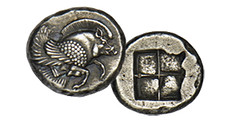 Intelligent, adaptable and omnivorous, pigs have long been
companions to humans. We know from cave paintings that Palaeolithic hunters pursued wild boars. The
earliest evidence for the domestication of pigs dates from about 8000 BCE (Larson). Even though it
is surrounded by many cultural and religious taboos, it’s no surprise that such a succulent and
versatile animal features prominently on ancient coinage.
Intelligent, adaptable and omnivorous, pigs have long been
companions to humans. We know from cave paintings that Palaeolithic hunters pursued wild boars. The
earliest evidence for the domestication of pigs dates from about 8000 BCE (Larson). Even though it
is surrounded by many cultural and religious taboos, it’s no surprise that such a succulent and
versatile animal features prominently on ancient coinage.
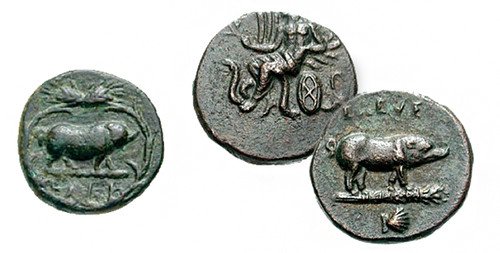
The Greeks: When Pigs Flew
The Greek imagination added wings to all sorts of unlikely creatures, including horses (Pegasus),
sphinxes, even girls (Nike, goddess of Victory).
And at least six Greek towns used the image of a winged boar on their coins: Klazomenai, Samos, Kyzikos, Ialysos, Kisthene and Mytilene. This winged boar is usually identified as Chrysaor, brother of Pegasus. On coins we only see the front half of the animal (the technical numismatic term is “protome” – which roughly translates as “first cut.”) The rest of Chrysaor shows up painted on the shield of Geryon, who fights Herakles on a famous cup painted by the artist Euphronios (ca. 500 BCE).
Non-magical, wingless pigs also appear on Greek coins, notably from the small town of Abakainon (or Abacaenum) on the northern coast of Sicily, where oak forests in the nearby mountains provided pasturage to great herds of pigs.

The Calydonian Boar One of the most celebrated legendary swine of antiquity was the Calydonian boar, an enormous beast sent by the goddess Artemis to ravage the land of Aetolia because the king had failed to pay her proper homage. The warrior prince Meleager gathered a team of heroes to hunt the terrible porker. The story was a popular theme in classical art, and we see the great shaggy boar, pierced by an arrow and harried by a slender hound on a denarius of 64 BCE issued by Hosidius Geta.
On Imperial coinage, the sow and piglets often appear, symbolizing prosperity to pork-loving Romans; for example, on a denarius of the emperor Vespasian issued in 77 CE.
The boar was a common design on the smallest regular denomination, the copper quadrans–notably those struck by the emperor Trajan (ruled 98-117 CE). The obverse of Trajan’s quadrans bears the bust of Hercules, so the reverse is surely the Erymanthian boar captured as the fourth labor of Hercules.
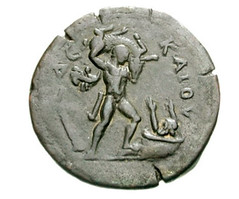 According to the myth, a giant, savage boar lived on
Mount Erymanthos (at 2224 m, or 7297 feet, the fourth-tallest peak in the Peloponnese). As
punishment for killing his family in a fit of madness, Hercules was obliged to perform a series of
12 impossible tasks, or “Labors” for King Eurystheus of Argos. Capturing the Erymanthian boar was
the fourth task. Hercules chased the animal into deep snow on the mountain and subdued it with his
superhuman strength. When he carried the beast back to Argos, the king was so terrified of it that
he hid inside a huge storage jar.
According to the myth, a giant, savage boar lived on
Mount Erymanthos (at 2224 m, or 7297 feet, the fourth-tallest peak in the Peloponnese). As
punishment for killing his family in a fit of madness, Hercules was obliged to perform a series of
12 impossible tasks, or “Labors” for King Eurystheus of Argos. Capturing the Erymanthian boar was
the fourth task. Hercules chased the animal into deep snow on the mountain and subdued it with his
superhuman strength. When he carried the beast back to Argos, the king was so terrified of it that
he hid inside a huge storage jar.
The scene is represented on a rare bronze drachm of Alexandria struck about 146 CE under the emperor Antoninus Pius. Roman Egypt had its own coinage, with Greek inscriptions and themes, and the large bronzes provided ample space for graphic storytelling.
To read the complete article, see:
This Little Piggy Went to Market: Boars, Hogs, Sows and Piglets on Ancient Coins
(www.coinweek.com/ancient-coins/little-piggy-went-market-boars-hogs-sows-piglets-ancient-coins/)
NUMISMATIC ITEMS DATED BY MONTH
The longest running series of month-dated coins must surely be Parthian tetradrachms, extensively discussed in books like David Sellwood's "Coinage of Parthia" and in Fabrizio Sinisi's Vol.7 of the more recent "Sylloge Nummorum Parthicorum". Although not contiguous, this series of month-dated pieces runs from the mid-late 1st cent BC to the early 3rd cent AD. Unfortunately, most specimens have a flan which is too small for the design, in consequence of which the month at the bottom is often not visible.
The Parthian calendar, like a number of other calendars past and present, operated on the basis of a 19-year-cycle, that period having long been known to correspond very nearly to an exact integer number (235) of lunar months. The practice was to intersperse seven leap years of thirteen lunar months as evenly as possible amongst twelve ordinary years of twelve lunar months; which leaves the question as to which years had the extra month. Without these tetradrachms it would probably have been all but impossible to answer, but there are nearly enough embolismic {leap month} issues that the pattern can be established.
There are other numismatic items which display not only the month but a day within the month; the most prolific probably being the communion tokens of Scotland. Where they do, however, this will nearly always be the date of foundation of the church or accession of the minister rather than the actual date of issue. There is also a solitary token in the British 17th century series, for William Wimble of Newington Butts {Williamson's Surrey 197} which displays a full date, 3 June 1652, on the reverse. The reason for this is, I believe, still unknown.
To read the earlier E-Sylum article, see:
IRISH GUN MONEY
(www.coinbooks.org/esylum_v17n45a35.html)
THE BOOK BAZARRE
FEATURED WEB PAGE: NUMISTA: GRIQUATOWN PENNY
This week's Featured Web Page is from the Numista site. It pictures a nice specimen of the Griquatown Penny.Country * Tokens * (Cape Colony)
Year 1890
Value 1 Penny (1/240)
Metal Copper
Weight 10.7 g
Diameter 30 mm
Thickness 1.95 mm
Engraver Otto Nolte
Shape Round
Orientation Coin alignment ??
Demonetized yes
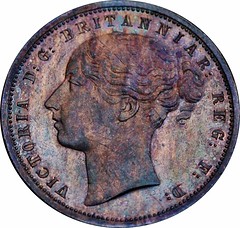

http://en.numista.com/catalogue/pieces52577.html


